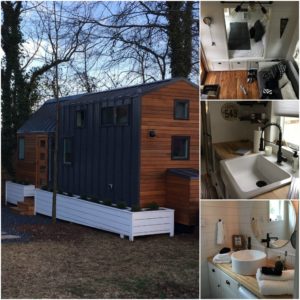April 27, 2018. By Courtney Summa:
With the average American home about 2,200 square feet, why are people choosing to live in a house between 250 and 500 square feet? Tiny houses are the new buzz amidst the real estate arena and what they lack in size they gain in efficiency. Shows such as Tiny House Hunters and Tiny House Nation highlight the construction of these homes thus increasing the awareness of their functionality. The minimal maintenance, low carbon footprint, and affordable price in comparison to the traditional homes on the market are attracting droves of millennials who cannot afford a traditional house due to college loans. On the opposite end of the spectrum these homes are also increasingly popular among retirees wishing to downsize. Additionally, traditional homeowners are building tiny houses on their property as a space for their guests, family members or caregivers, or renters providing extra income.
Third-party home rental services are also capitalizing on these miniature mansions. My husband and I had the opportunity to stay in a tiny home that was 291 square feet while we were exploring the south for two weeks – a welcomed change to the typical hotel stay. It was a total shock to see how spacious the rental felt. It was not claustrophobic, but instead very roomy and homey. This tiny house had 2 full size beds, one in the loft and the other in a closed private room. It had a full-size bathroom, which included a washer/dryer. The kitchen had a beautiful farm sink, a couple hot plates, and a medium size fridge. The living space simply had a love seat and a small television mounted on the wall. There was a second, smaller loft that we figured could be used for storage if desired. Overall the storage drawers under the private bedroom was a well-designed solution. It was truly a beautiful home:
After staying in this house for a couple nights, it got us thinking…would we be able to live in such a space? What would it cost to build the house? Is the cost efficiency really worth the sacrifice one or two thousand square feet?
Lower carbon footprint: Tiny homes tend to be greener because they consume less energy during use and require fewer materials to build, and less waste to dispose or renovate if necessary. Less water is used since basins, sinks, and heaters are much smaller.
Monthly Savings: Naturally great savings would be incurred on heat, cooling, and home maintenance costs. An often-overlooked benefit, however, pertains to the smaller appliances needed to suit the space. With a smaller fridge and pantry, you will be spending less on groceries, and would be forced to be more thoughtful in your shopping selections.
Less Clutter: Due to limited space, individuals living in tiny homes are forced to adopt a minimalist mentality. They don’t hold onto unnecessary items, and everything has a place. Owners must carefully consider the items they purchase, and organization is key.
Lower Construction Costs: According to an article on realtor.com, tiny homes can be built for as little as $8,000 including permits, materials, labor, insulation, electricity, and plumbing. A more common range seems to be between $25,000 and $35,000 for a 200 square-foot home. Again, this is for bottom-up construction. Not handy? Companies such as 84 Lumber provides luxury tiny homes completely built and delivered to your property.
There are certainly positives of choosing the option of extreme downsizing; however, there are a few aspects that could be big negatives for some personalities. Although tiny houses are designed with spatial awareness in mind, maintaining that level of organization and cleanliness is more than a habit, it’s a lifestyle. There isn’t room to leave shoes by the door, or dishes in the sink. The more clutter in the house, the more difficult it will be to function day-to-day. Lastly, entertaining guests can be a challenge. They only way entertaining really works is having everyone outside; this would be especially trying in New England and seasonal regions. On the bright side, living in a smaller space encourages people to be outdoors more and enjoy life outside the home.
Tiny house living isn’t for everyone, but for some people it is a simple, peaceful solution for their residential needs. My husband and I are going to stick with our extra square footage for now (our pups are not yet onboard with the idea of downsizing); however, we are definitely looking forward to using tiny homes for vacation stays in the future.
(These two enjoy their extra wiggle room, even if they don’t take up much space)


